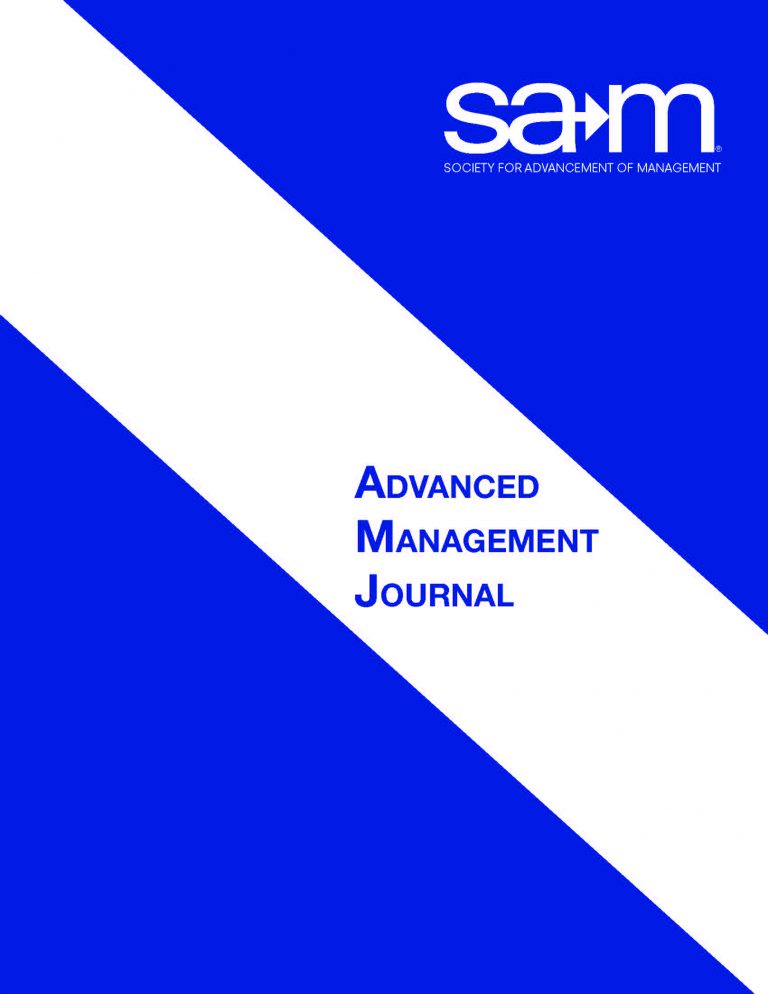Volume 85 Edition 4 | Autumn 2020
Transformational Leadership and the Moderating Role of Trust and Job Satisfaction on Organizational Citizenship Behavior
Jack McCann, Betsy Sparks, and Thomas Kohntopp
This study examined the relationship between transformational leadership, interpersonal trust at work, job satisfaction, and organizational citizenship. Measures of transformational leadership behaviors, employees’ trust at work, job satisfaction, and corporate citizenship were obtained from a sample of 157 manufacturing employees in the United States using a web-based survey. The survey results were analyzed using Partial Least Squares Structural Equation Modeling (PLS-SEM). Manufacturing employees with supervisors who exhibited transformational leadership indicated that they had exhibited corporate citizenship behaviors in their organizations. Job satisfaction and interpersonal trust at work also contributed to employee corporate citizenship but did not moderate the relationship between transformational leadership and corporate citizenship.
Multi-step Operations Strategic Framework for Ransomware Protection
Kamala Raghavan, Mayur Desai, and P.V. Rajkumar
Governments and public entities across the globe are facing a growing threat of cyberattacks and escalating ransom demands with the attacks crippling their systems and costing them time and money in getting back to normal state. Governments and public institutions are large targets with valuable data assets, vulnerable technology and relatively weak security as compared to the corporate sector. These entities operate in a network of connected information systems out of necessity but are generally less prepared than corporations to combat cyber-attacks due to limited cybersecurity talent and software resources. They are relying increasingly on technology to deliver services to stakeholders to cut costs but using outdated computer systems. The purpose of this paper is to study the evolution of ransomware incidents and propose a multi-step operations strategic framework to protect the data and minimize the impact on critical services to stakeholders from ransomware. The proposed strategy consists of three verticals that contextualize and organize the cybersecurity technologies and procedures focused on the operations perspective.
A New and Improved Organizational Structure Decision-Making Model
Forest R. David, Meredith E. David, and Fred R. David
Businesses of all sizes and types around the world yearn for an effective organizational structure as they face rival firms committed to defeating them in the marketplace. Although the function of “organizing” is a key activity of management, scant literature provides either a theoretical or empirical basis for when, why, and how various types of structure are appropriate under various scenarios of organizational characteristics. From an extensive literature review, we determined there are 1) ten key characteristics of a firm that significantly impact structural design, 2) seven basic types of structure, and 3) three rudimentary characteristic-structure typological models. Existing typology models however do not adequately provide direction for companies or organizations making organizational structure decisions. Based on the characteristics, structure types, and prior typologies, we develop a new mathematical model that can reveal the best structure for any given firm. This paper provides a four-fold, substantial contribution to the management discipline by: 1) revealing ten basic organizational characteristics that can be used to guide organizational structure decision-making, 2) revealing seven basic types of organizational structure, 3) developing and presenting a new, improved model for determining the best structure for any firm, and by 4) proposing clear direction for future organizational structure research aimed at refining and enhancing the new model.
A Framework to Apply Porter and Kramer’s “Creating Shared Value” Approach: Evidence from a Business Model’s Success and Failure in Africa
Santosh Nandi, Madhavi Latha Nandi, and Hendrikus van Bulck
The purpose of the study is to demonstrate how to apply Porter and Kramer’s “Creating Shared Value” (CSV) in developing sustainable business models for international markets. The study proposes a framework to apply CSV and discusses its application by using Vodafone UK’s success in Kenya and failure in South Africa of M-Pesa – its mobile-based financial service business model. Through the proposed framework, the study highlights that three of the four CSV strategies, i.e., (1) reconceiving products and markets, (2) redefining productivity in the value chain, and (3) defining core competence, are process-focused and have direct influence on business model success. The fourth CSV strategy – (4) enabling local cluster development, intensifies the performance of the three process-focused CSV strategies on business model success. In addition, ‘regulatory fit’ of the business strengthens the direct performance of the process-focused CSV strategies on business model success. The proposed framework serves as useful guiding tool for researchers to evaluate and extend CSV’s theoretical juxtapositions and for practitioners to justify CSV approach in developing business models for markets with matching and/or differing socio-economic and socio-political contexts.
The Effect of Ownership Structure (Share Book Nationality) and Board Independence on EPS in the Jordanian Insurance Sector
Houda Aleqedat and Anita Tangl
This study aims to investigate the effect of ownership structure, independence of the board on insurance companies’ performance in Jordan measured by earnings per share for the years (2013- 2018). Based on agency theory, the data presented has been collected from the financial annual report of the Amman Stock Exchange (ASE). The sample of the study is the (23) insurance companies for the years (2013 – 2018). To test the hypotheses and models of study, the SPSS program has been employed by using: Descriptive statistics, Multicollinearity test, Pearson correlation, multilinear regression analysis. Results show that Arab and government ownership structures have a negative and significant effect on EPS. Foreign has a positive and significant effect on EPS. The largest OWS has a positive but not significant effect on the EPS. The independence of the board has a negative and significant effect on EPS.


